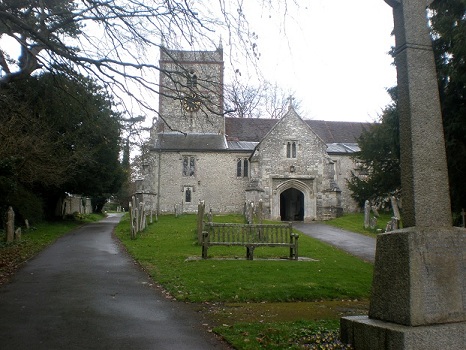By Tim Lambert
Early Hambledon
Hambledon has been inhabited for thousands of years. In 1997 stone axes were found in West Street. They were made about 2,500 BC. At that time people in England lived by farming but they made stone tools. Much later there was a Roman villa by Bury Lodge.
However, ‘modern’ Hambledon began as a Jutish or Saxon village. Hambledon first appeared in history in the year 956 when it was mentioned in a document. The second part of its name ‘don’ is derived from ‘dun’ the Saxon word for hill. It is not known for certain where the first part of its name comes from. It may be a corruption of somebody’s name or it may be derived from a word meaning crooked.
At the time of the Domesday Book in 1086 Hambledon probably had a population of around 100. To us, it would seem tiny but villages were very small in those days. Hambledon did have one watermill where grain was ground into flour for the villagers.
Hambledon had a church from Saxon times. The Church of St Peter and St Paul was enlarged in the 13th century as the community grew.
In the Middle Ages Hambledon was in the midst of the Forest of Bere, which stretched from the border with Sussex to Winchester.
However, the village grew more important with time. In 1256 Hambledon was granted a weekly market. (In those days there were few shops and if you wished to buy or sell anything you had to go to a market).
Hambledon 1500-1800
In 1612 another change came. Hambledon was allowed 2 annual fairs. (In those days fairs were like markets but they were held only once a year and they attracted buyers and sellers from a wide area). One fair was held on the Feast of the Purification of the Blessed Virgin (2 February). The other was held on St Matthew’s Day (21 September).
In 1725 Hambledon suffered a disastrous fire, which destroyed many buildings in the High Street. Another fire in 1788 severely damaged the church tower. It was largely rebuilt in 1794.
Hambledon is, of course, famous for cricket. A game resembling cricket was played for centuries before Hambledon cricket club was formed around 1750. (Although Hambledon Cricket Club was first actually mentioned in 1756). The name may come from a Saxon word cricc meaning a long pole of wood. A ‘criccett’ may have been a short pole of wood. At any rate, by the early 17th century a game similar to modern cricket was being played.
However, Hambledon was the first cricket club. It was led by Richard Nyren the landlord of the Bat and Ball. Hambledon Cricket Club was remarkably successful. They won 29 games against an all-England team. They also beat Kent 19 times and Surrey 12 times. In June 1777 Hambledon played England for 1,000 guineas (a huge sum of money) and won! The last recorded game played by the original team was at Lords in 1793. In 1908 a monument was erected on Broadhalfpenny Down to commemorate the original club.
Meanwhile, the first recorded game of women’s cricket was held on 26 July 1746. Ladies from Hambledon played ladies from the village of Bramley in Surrey. Hambledon won 127 to 119. (There was no actual women’s cricket n in England till 1887).
Meanwhile, in 1782 John Taylor, a blacksmith from Hambledon, met James Stares from Soberton. The two left together and Taylor attacked and robbed Stares. Taylor was executed in 1783.
In 1779 a group of volunteers was formed in Hambledon to fight if England was invaded. They stood down in 1781 but in 1803, the Hambledon Volunteers were reformed to fight the French if they invaded. They stood down in 1810.
Modern Hambledon
The state did not provide education until 1870 but earlier the churches provided schools. A national (Church of England) school was built in Hambledon in 1849. (It is now Hambledon Infants School).
In 1853 William Cobbett wrote about Hambledon: ‘It is a long, straggling village lying a little valley formed of pretty but not lofty hills’. Hambledon Methodist Church was built in 1864.
In 1883 Hambledon suffered an outbreak of diphtheria. (In the 19th century it was a deadly disease that killed many children) There was another outbreak of diphtheria in 1933.
On a lighter note in 1882 a man named Francis Hartridge bought a brewery in Hambledon. In 1884 he also began to make soft drinks. In August 1940 a German plane bombed the brewery and almost destroyed it but the soft drinks plant was left intact. After that Hartridges concentrated on soft drinks.
From 1884 the streets of Hambledon were lit, at first by oil lamps and later by gas then electricity.
Hambledon lost 33 men in World War I. A further 8 men were killed in World War II.
In 1953 a vineyard was created at Hambledon by Sir Guy Salisbury-Jones. The first wine was made in 1955.
In 1969 the Bishop of Portsmouth held a service of dedication after the church was refurbished. (A new organ was obtained and a new tile floor was laid in part of the church). At the beginning of the millennium, a new chapel was added to the church. Hambledon Village Hall opened in 1982.
Today some of the old pubs in Hambledon have gone but there is still a 16th-century inn called The Vine, which has a 30ft well. There is also the Bat and Ball.
Like many villages, Hambledon has gradually lost its shops. Hambledon Bakery closed in 1989.
In 1991 Hambledon was twinned with the French village of Reville. In the 1990s affordable housing was built at Lashly Meadow. It is named after a stoker called William Lashly who was born in Hambledon. When he died in 1940 he was buried in the churchyard.

In 2005 the church roof had to be replaced. Today Hambledon remains a prosperous village. Today the population of Hambledon is about 950.